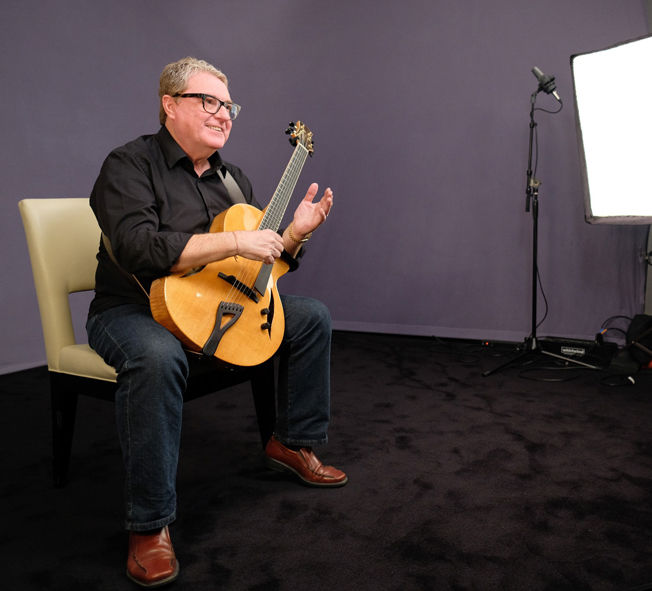DITCH THE PICK - MARTIN TAYLOR
- FIBONACCI GUITARS
- Feb 8, 2021
- 3 min read

Figuring out Fingerstyle Guitar
What is fingerstyle? You may have heard the term fingerstyle used synonymously with fingerpicking, but the two are really quite a bit different. Fingerpicking generally involves moving between the thumb on the bass notes and the fingers on treble notes, and builing around patterns for your fingers. These recognizable patterns can be applied to many different kinds of music and sound great. Fingerstyle guitar blends bass and treble together, with your fingers and thumb working all of the strings together. Watch fingerstyle guitarist Martin Taylor playing "They Can't Take That Away from Me" in the above video. You can hear bass and treble notes together, with the thumb and the fingers moving across the instrument rather than following distinct patterns. One of the great advantages of playing fingerstyle guitar lies in its ability to bring each note to life. Strumming styles tend to create a chord focus, whereas tapping and picking emphasize some of the notes you play over others. Fingerstyle guitar weaves a tapestry of sound, each sound critical to the whole piece you create. Whether a quick-moving piece or a somber ballad, each note has a chance to ring out on its own. As you develop as a guitar player, you can begin experimenting with different techniques to get the sound you are looking for. You can work with different kinds of strings, different instruments, and different techniques. Strumming, finger picking, tapping, and sliding can all fit into your repertoire. For playing out melodies with a classic jazz feel, though, fingerstyle guitar takes you a long way as an artist. It requires quick fingers, stamina, and the ability to blend your bass and melody lines into one in both your hands and your ears. When you put it together, you can develop a consistent tone that feels great. Moving Away from the Pick Many guitar players begin using a flat pick, which lets them strum or pluck out a melody without the stress to their fingertips. Some music works well with a pick, but working with fingerstyle gives you more freedom to move around your arpeggios and gain more freedom all around the guitar, moving among strings more freely. It may also help you feel your guitar more as you play, since your fingertips and thumbtips are physically hitting each string as you play. When you do use fingerstyle guitar, generally nylon strings work better than steel or other metal strings, as they give you a level of comfort as you play. A D'Addario nylon string can give the warm tone many of the great fingerstyle players produce.
Traditions of Fingerstyle Guitar
When you move through jazz guitar history, many of the pioneers and greats used fingerstyle techniques. Two of the leaders in this area, Eddie Lang and Carl Kress, can be heard together here on "Pickin' My Way," with their fingers not only running the gamut on their individual instruments, but working together to blend their distinctive sounds together. The tone and ring from each note provide some of the best examples of what fingerstyle guitar can be.
Another jazz guitar giant, Django Reinhardt, made fingerstyle guitar the centerpiece of the gypsy jazz movement, accompanied primarily by other string instruments. On "Brazil," for example, he gave a performance that shows some of the great range the style can create, from ringing tremolo notes to quick-moving melodic lines.
Similarly, Wes Montgomery demonstrated well the tonic beauty the style can create on "Round Midnight," a standard that practically sings from his guitar in this piece. Fingerstyle guitar allows each note to resonate here, in a way other styles of guitar play would have trouble replicating.
Learning to Play Fingerstyle Fingerstyle guitar requires a devotion to play that focuses both on the sound of each note and on the overall fit and feel within the melody. Music of any kind works because it moves: through crescendos and decrescendos, through melodic lines and harmonies, through dissonance and resolution. As you learn fingerstyle, you feel each note along the way and learn to find its part within the whole. It takes patience and willingness to work through the process, but can lead to incredible, beautiful guitar play. Learn fingerstyle guitar online with Martin Taylor at ArtistWorks and get feedback on your playing when you submit videos! https://my.artistworks.com/blog/figuring-out-fingerstyle-guitar?fbclid=IwAR1xHFxJ3QjsttE_vTmgitKBnNWP8LPmoanobL_VfOzRaEZPxBIdFJhIqe0


Comments